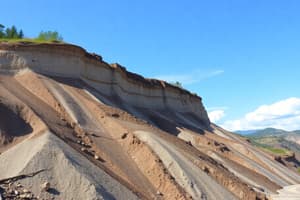Podcast
Questions and Answers
How does vegetation contribute to slope stability?
How does vegetation contribute to slope stability?
- It repels rain and winds, keeping the ground dry.
- It increases the water content in the soil.
- Its roots anchor the soil and prevent mass wasting. (correct)
- It prevents soil erosion by blocking sunlight.
What is the primary effect of an earthquake on a slope?
What is the primary effect of an earthquake on a slope?
- It significantly lessens the shear force within the slope. (correct)
- It increases the friction within the slope.
- It has no noticeable impact on slope stability.
- It causes the shear force within the slope to increase.
Which of the following events is an example of mass wasting?
Which of the following events is an example of mass wasting?
- Droughts causing soil shrinkage.
- Flooding due to heavy rainfall.
- Avalanches in low-lying areas.
- Landslides caused by earthquakes. (correct)
What kind of mass-wasting event occurs when the lower portion of a slope deteriorates?
What kind of mass-wasting event occurs when the lower portion of a slope deteriorates?
What indirect impact can mass-wasting events have on a community?
What indirect impact can mass-wasting events have on a community?
What environmental factor significantly correlates with an increase in mass-wasting events in Nepal?
What environmental factor significantly correlates with an increase in mass-wasting events in Nepal?
How often do earthquakes occur on Earth annually?
How often do earthquakes occur on Earth annually?
What defines mass wasting in geology?
What defines mass wasting in geology?
Which of the following measurements is NOT essential when documenting a mass-wasting event?
Which of the following measurements is NOT essential when documenting a mass-wasting event?
Which of these factors is NOT associated with triggering mass wasting?
Which of these factors is NOT associated with triggering mass wasting?
What generally causes an increase in the likelihood of mass wasting events?
What generally causes an increase in the likelihood of mass wasting events?
How does excessive water contribute to mass wasting?
How does excessive water contribute to mass wasting?
What is shear strength in the context of mass wasting?
What is shear strength in the context of mass wasting?
Which type of mass-wasting event typically occurs rapidly?
Which type of mass-wasting event typically occurs rapidly?
What material does mass wasting NOT typically include?
What material does mass wasting NOT typically include?
Flashcards
Mass Wasting Definition
Mass Wasting Definition
The down-slope movement of rock and soil due to gravity.
Vegetation's Role in Preventing Mass Wasting
Vegetation's Role in Preventing Mass Wasting
Plant roots act as anchors to hold soil in place. Plants also reduce water buildup and protect soil from wind and rain.
Earthquake Effect On Mass Wasting
Earthquake Effect On Mass Wasting
Earthquakes decrease friction within slopes, making mass wasting more likely.
Types of Mass Wasting: Avalanches
Types of Mass Wasting: Avalanches
Signup and view all the flashcards
Types of Mass Wasting: Landslides
Types of Mass Wasting: Landslides
Signup and view all the flashcards
Factors Increasing Mass Wasting Risk
Factors Increasing Mass Wasting Risk
Signup and view all the flashcards
Mass-Wasting Impacts
Mass-Wasting Impacts
Signup and view all the flashcards
Mass Wasting
Mass Wasting
Signup and view all the flashcards
Mass Wasting Rate
Mass Wasting Rate
Signup and view all the flashcards
Mass Wasting Motion
Mass Wasting Motion
Signup and view all the flashcards
Mass Wasting Material
Mass Wasting Material
Signup and view all the flashcards
Shear Strength
Shear Strength
Signup and view all the flashcards
Mass Wasting Trigger
Mass Wasting Trigger
Signup and view all the flashcards
Increased Water (Mass Wasting)
Increased Water (Mass Wasting)
Signup and view all the flashcards
Increased Slope Steepness (Mass Wasting)
Increased Slope Steepness (Mass Wasting)
Signup and view all the flashcards
Study Notes
Mass Wasting: A Geological Overview
- Mass wasting (slope failure) is the large movement of rock, soil, and other geologic materials downhill due to gravity.
- Key measurements for documenting mass wasting events include rate (speed), motion (how material moves), and material (what moves).
- Rates vary from minutes/seconds (landslides, avalanches) to months/years (slumps), while motion includes falling, sliding, flowing. Material encompasses geological materials, vegetation, snow, and human structures.
- Mass wasting is infrequent due to the shear strength (resistance) of land, particularly in solid formations like mountains.
Causes of Mass Wasting
- Triggers include:
- Increased water saturation: Heavy rainfall can oversaturate slopes, making soil unstable and causing erosion, though erosion can slowly undermine slope integrity leading to large-scale mass wasting.
- Increased slope steepness: Steeper slopes have lower shear strength due to gravity.
- Vegetation removal: Plant roots hold soil together. Loss of vegetation due to wildfires, disease, or unsustainable human practices (clearcutting) decreases soil stability.
- Earthquakes: Earthquakes reduce shear strength by increasing movement within geologic materials, leading to landslides and other mass movements.
Types of Mass Wasting
- Avalanches (rock and snow): Rapid movement of geologic materials.
- Slumps: Slope failures with a distinctive curved shape.
- Rockfalls: Rocks falling from cliffs.
- Earth flows: Rapid movement of earth.
- Debris flows: Fast-moving flows of earth with debris (boulders, trees, infrastructure).
Impacts of Mass Wasting
- Direct impacts: Injuries, property damage, disruption to daily life, loss of wages (work), harm to livestock/wildlife, and damage to transportation.
- Indirect impacts: Reduced property values, decreased tourism, increased rebuild costs due to safety regulations (retaining walls).
Examples of Mass Wasting Events
- 2017 California landslide (Gorda): Heavy rainfall on a burn scar triggered coastal collapse.
- 2021 Nepal: Himalayan region experienced a 30-year high of mass wasting events due to heavy monsoon rainfall, impacting socioeconomic development.
- 2018 Japan: Numerous landslides affected highways and forests, highlighting the vulnerability of mountainous regions with high seasonal rainfall and earthquakes.
- 1994 California Northridge Earthquake: Caused over 11,000 landslides, demonstrating the significant secondary impacts of earthquakes.
Studying That Suits You
Use AI to generate personalized quizzes and flashcards to suit your learning preferences.
Description
Explore the principles of mass wasting, including its causes and mechanisms. Understand key concepts such as rate, motion, and material involved in these geological processes. Learn how factors like water saturation and slope steepness contribute to slope failures.





